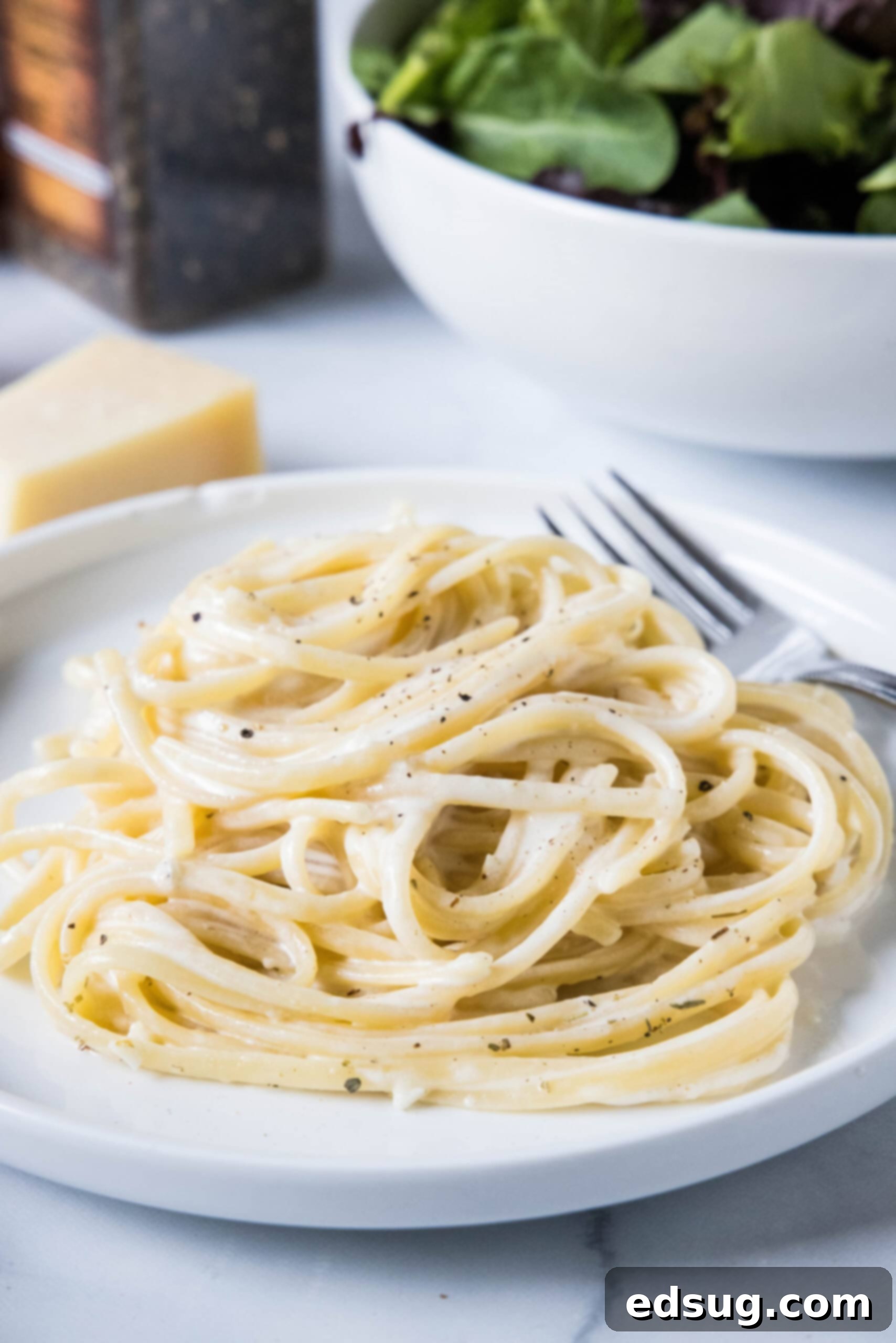The Ultimate Homemade Alfredo Sauce: Rich, Creamy, and Incredibly Easy!
Prepare yourself for the best homemade Alfredo sauce you’ll ever taste! This luxurious, creamy sauce is a testament to simple ingredients creating extraordinary flavor. Crafted with just four core components, it’s infused with those classic garlic and Parmesan notes we all adore. Best of all? It comes together effortlessly in a single pan, ready to coat your favorite pasta for a truly satisfying meal. Forget store-bought versions – once you try this easy homemade Alfredo, there’s no going back.
I have a soft spot for dishes that celebrate simplicity, much like my parmesan gnocchi with sage butter. This homemade Alfredo recipe perfectly embodies that philosophy. For those who love exploring different cream sauces to elevate their pasta, my roasted garlic cream sauce is another delightful option worth trying.
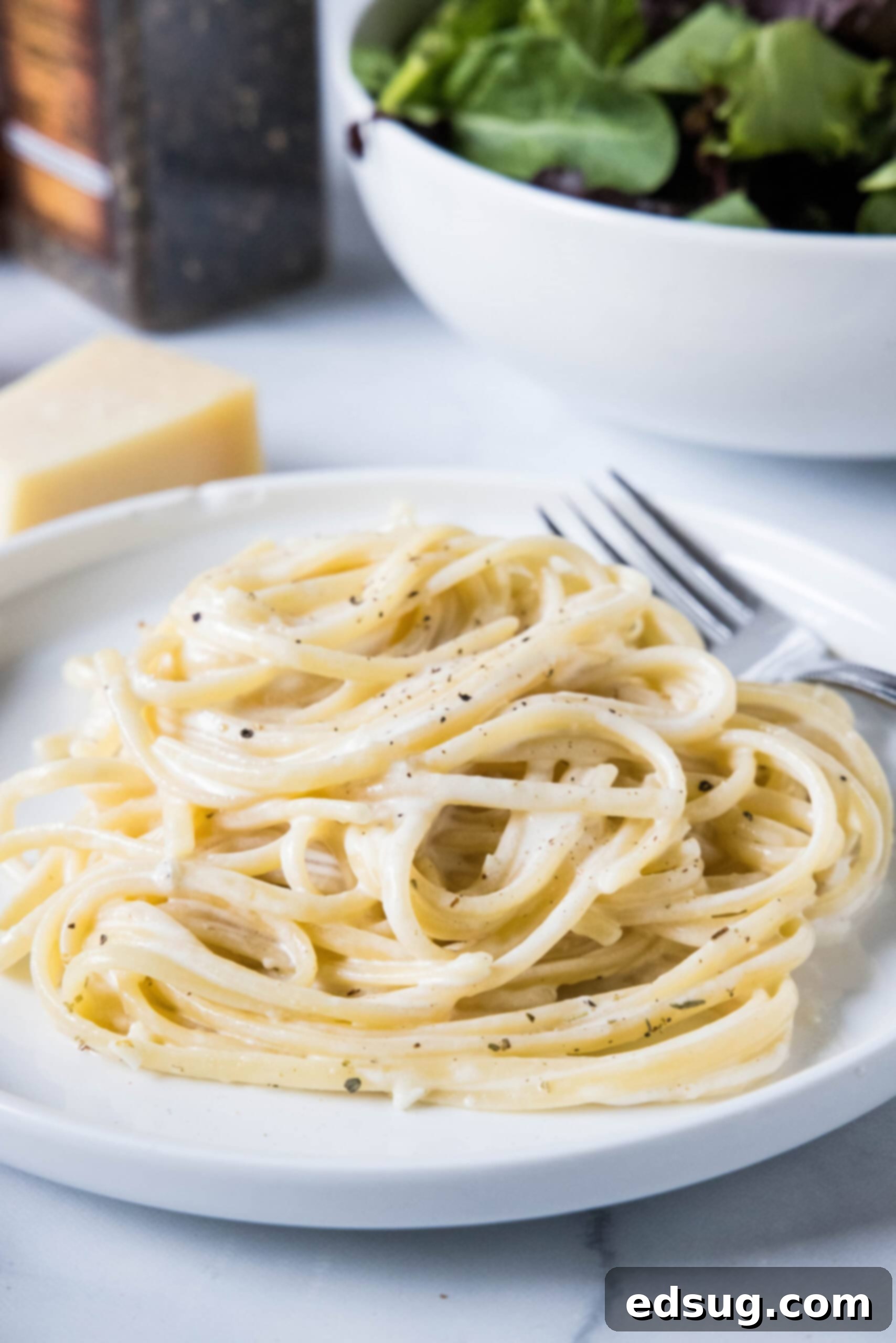
Table of Contents
- Why You’ll Love This Easy Homemade Alfredo
- What Is Alfredo Sauce?
- Ingredients You’ll Need
- How to Make Alfredo Sauce
- Easy Fettuccine Alfredo
- The Secret to Thick Alfredo Sauce
- More Recipe Tips
- What Else Can I Add to Alfredo?
- Frequently Asked Questions
- Serving Suggestions
- Storing and Reheating Leftovers
- More Homemade Pasta Sauces
- Homemade Alfredo Recipe
There’s an undeniable comfort that comes with a generous bowl of creamy Alfredo pasta. Perhaps it’s the alluring combination of rich garlic and sharp Parmesan, or the irresistibly silky texture that coats every strand of pasta. While I may be a little biased, I genuinely believe our family’s recipe for homemade Alfredo sauce surpasses any other I’ve encountered! This incredible sauce requires merely four essential ingredients and a few quick minutes to prepare on your stovetop. The beauty of this recipe is its simplicity: once the sauce is perfected, you can directly add cooked fettuccine (or your pasta of choice) to the skillet, transforming it into a convenient one-pan meal that consistently earns rave reviews from everyone at the table. Seriously, there’s no comparison between this fresh, vibrant homemade creation and any jarred Alfredo sauce you might find.
Why You’ll Love This Easy Homemade Alfredo
This easy homemade Alfredo isn’t just another pasta dish; it’s a culinary experience designed for convenience, versatility, and undeniable deliciousness. Here’s why this recipe is bound to become a staple in your kitchen:
- One Pan Wonder. Preparing a gourmet-tasting meal with minimal cleanup is always a win, and this Alfredo delivers exactly that. With just a single skillet required for both the luscious sauce and the final pasta toss, you’ll spend less time washing dishes and more time savoring your meal. It’s the perfect solution for busy weeknights or when you simply want to enjoy a delicious dinner without the fuss.
- Incredibly Versatile. While fettuccine Alfredo is a classic for a reason, this creamy sauce is incredibly adaptable to any pasta shape your heart desires. Whether you prefer long strands like linguine or spaghetti, or robust short-cut pastas like penne, rigatoni, or even delicate tortellini, this recipe provides enough rich Alfredo sauce for approximately one pound of pasta. Feel empowered to adjust the recipe quantity up or down to perfectly suit your gathering size.
- Effortlessly Adaptable. Beyond pasta choices, this homemade Alfredo sauce offers a fantastic base for customization. You can effortlessly transform its flavor profile and substance with various add-ins, fresh seasonings, or different serving ideas. Dive into the suggestions below for easy ways to make this Alfredo uniquely yours, catering to different tastes and dietary preferences.
What Is Alfredo Sauce?
The story of Alfredo sauce dates back to Rome, Italy, where Alfredo di Lelio created what he called “Fettuccine all’Alfredo” for his pregnant wife. His original recipe was remarkably simple, featuring just two ingredients: fresh butter and finely grated Parmesan cheese. The magic of its creaminess came from the butter emulsifying with the cheese and the starches naturally released from the pasta itself – no cream in sight! However, as the dish traveled and evolved, particularly gaining popularity in America, the recipe for Alfredo sauce transformed. Modern versions, like this one, frequently incorporate heavy cream to achieve an even richer, more stable, and undeniably luxurious texture. I’ve also enhanced my recipe with fresh garlic, adding another layer of aromatic flavor that truly complements the creamy Parmesan. This contemporary take offers the beloved richness and smoothness many associate with classic Alfredo today.
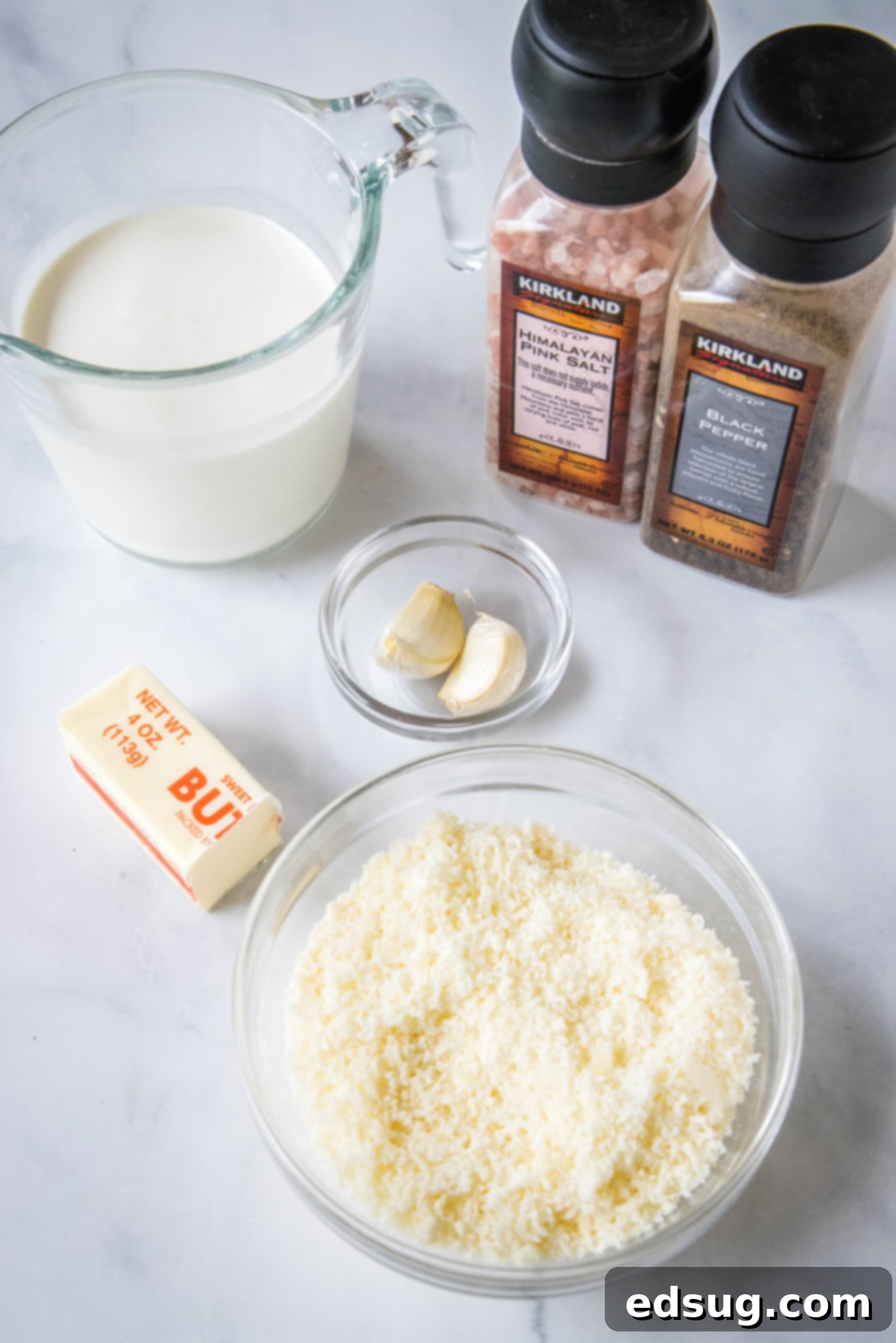
Ingredients You’ll Need
Creating this exceptional homemade Alfredo requires only a few high-quality ingredients. Each plays a vital role in achieving that rich, creamy, and flavorful profile we crave. I’ll walk you through each component here. For a convenient printable list with precise measurements, please refer to the recipe card further down this page.
- Butter – I always opt for unsalted butter. This gives you complete control over the final saltiness of your sauce. If you choose to use salted butter, remember to adjust and potentially reduce the amount of additional salt you add later in the recipe.
- Garlic – The aromatic foundation of our Alfredo! Freshly minced garlic is absolutely essential here. Pre-minced garlic in a jar simply won’t deliver the same vibrant, pungent flavor that fresh cloves do. Don’t skip this step for the best results.
- Heavy Cream – This is the magic ingredient that gives our modern Alfredo its signature velvety smoothness and decadent richness. While you *can* substitute with milk or half-and-half, be aware that these alternatives will result in a slightly thinner sauce and a less indulgent texture. Heavy cream ensures maximum creaminess.
- Parmesan Cheese – The undisputed star of any Alfredo sauce! For unparalleled flavor and a smooth, lump-free melt, always use freshly grated Parmesan cheese. Avoid the pre-shredded varieties often found in tubs, as they contain anti-caking agents that can prevent smooth melting and lead to a grainy texture. Invest in a good quality block of Parmesan, Parmigiano-Reggiano, or even Pecorino Romano for a sharper kick – it truly makes all the difference.
- Salt and Pepper – These foundational seasonings are added to taste, allowing you to fine-tune the flavor balance. Don’t be afraid to experiment with other additions! Consider a pinch of Italian seasoning for a herbaceous note, or fresh herbs like parsley or chives to brighten the profile. I’ll share more easy suggestions later to inspire your custom creations.
How to Make Alfredo Sauce
Crafting this creamy homemade Alfredo is surprisingly simple and can be accomplished in a matter of minutes, making it an ideal choice for a quick and satisfying dinner. The secret to its success lies in maintaining a steady, moderate heat and consistent whisking to ensure a perfectly smooth and emulsified sauce. Follow these straightforward steps for a truly delicious result:
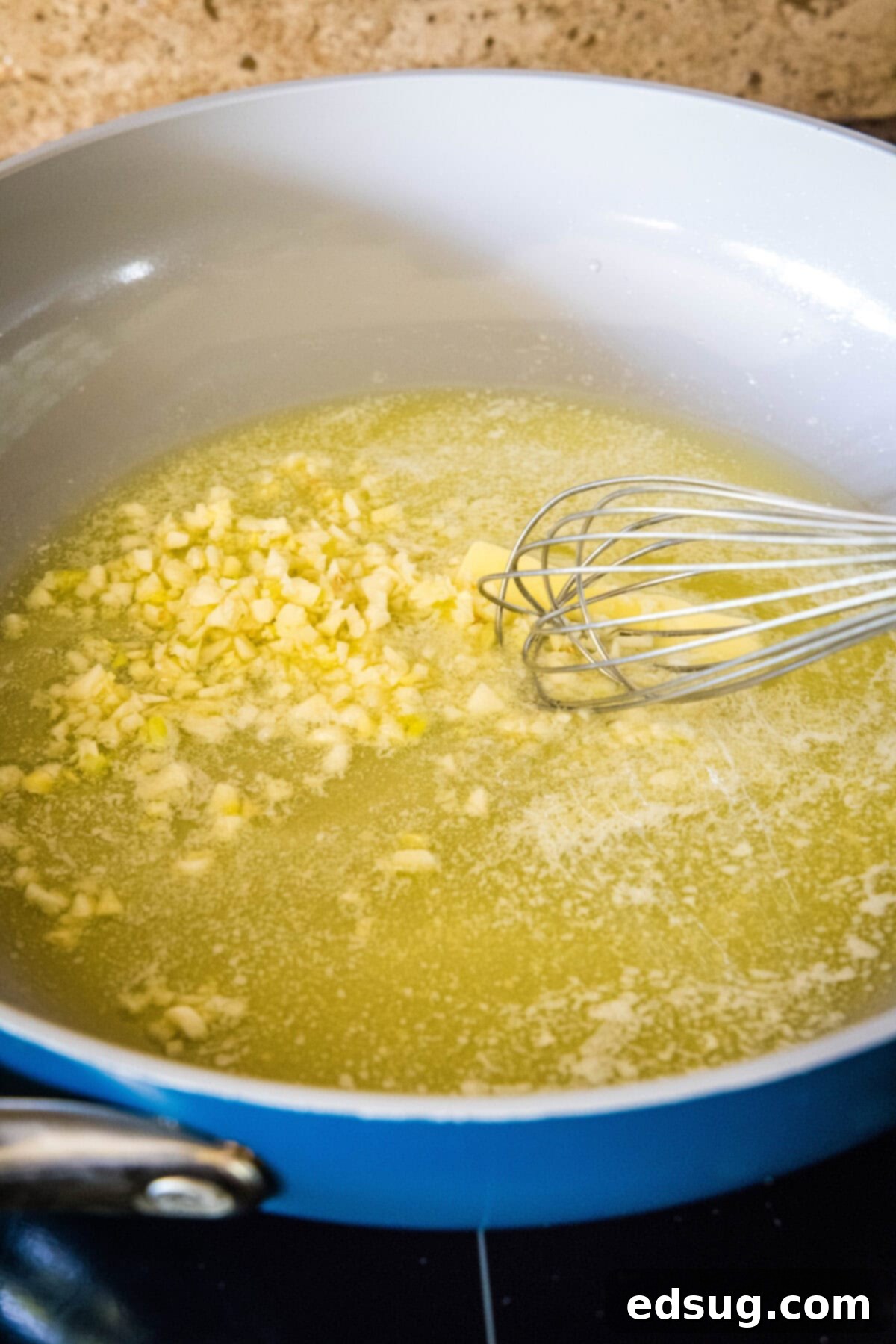
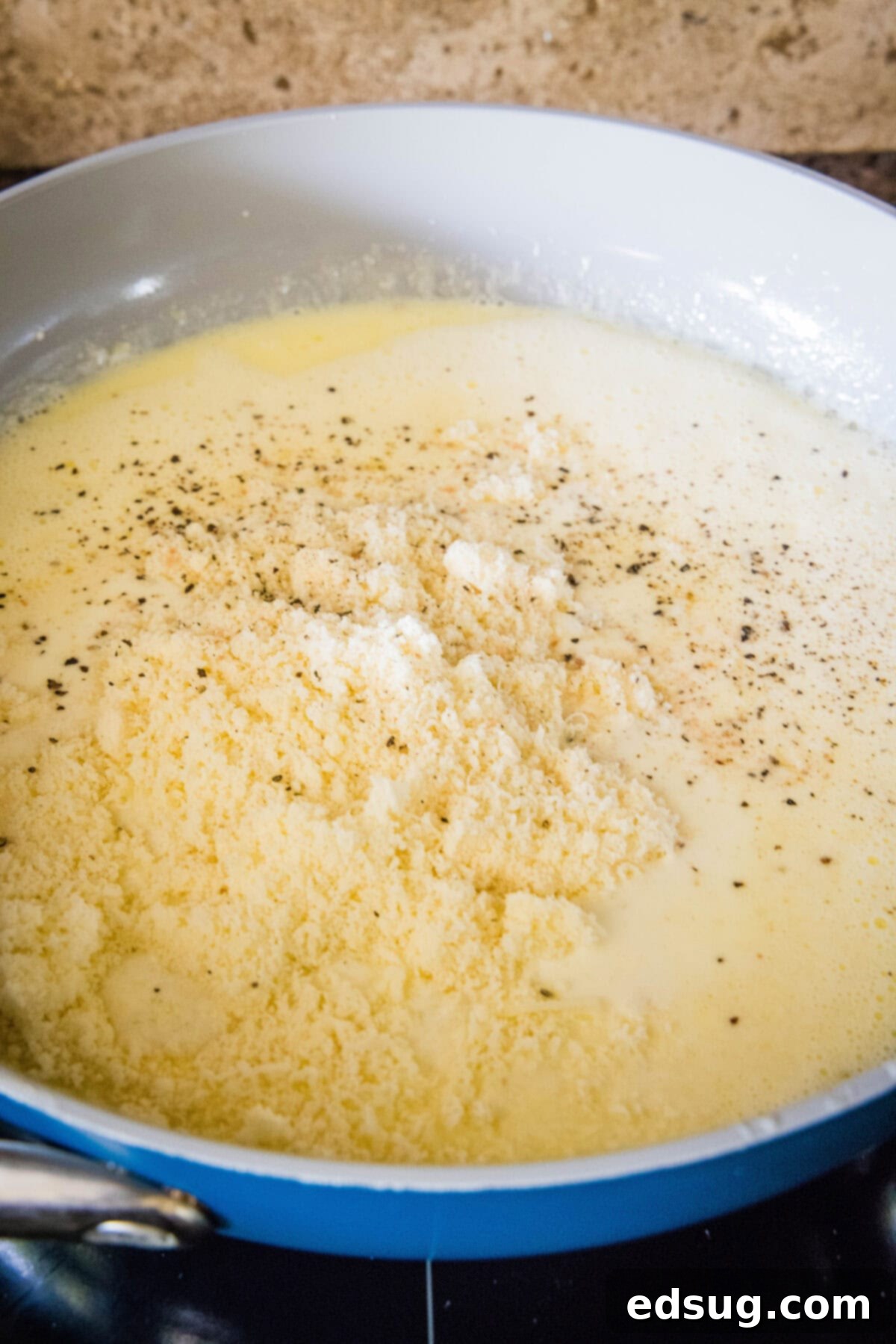
- Sauté aromatic garlic in a skillet. Begin by melting your unsalted butter in a medium-sized saucepan or large skillet over medium heat. Once melted and shimmering, add your freshly minced garlic. Sauté for just 1-2 minutes, stirring constantly, until the garlic becomes fragrant and lightly golden. Be careful not to let it brown or burn, as this can make it bitter.
- Whisk in the heavy cream. After the garlic is fragrant, pour in the heavy cream. Whisk continuously as you add it to fully incorporate with the butter and garlic. Allow the mixture to come to a gentle simmer, letting it cook for about 5 minutes. It’s crucial here to monitor the heat carefully and ensure the cream never reaches a rolling boil, as high heat can cause dairy to separate.
- Melt in the Parmesan. Once the cream has gently simmered and slightly reduced, remove the pan from the direct heat or reduce it to its lowest setting. Gradually add the freshly grated Parmesan cheese, whisking constantly until the cheese has completely melted into the sauce and it achieves a perfectly smooth, velvety consistency. Season generously with salt and freshly ground black pepper to taste. Your homemade Alfredo sauce is now ready for your favorite pasta!
Easy Fettuccine Alfredo
Fettuccine has long been the quintessential pasta choice for Alfredo sauce, and it’s certainly my go-to! Its broad, flat, and long strands are ideal for capturing and clinging to every luxurious drop of the creamy Alfredo, ensuring each bite is perfectly coated. Here’s how to create a magnificent fettuccine Alfredo that rivals any restaurant version:
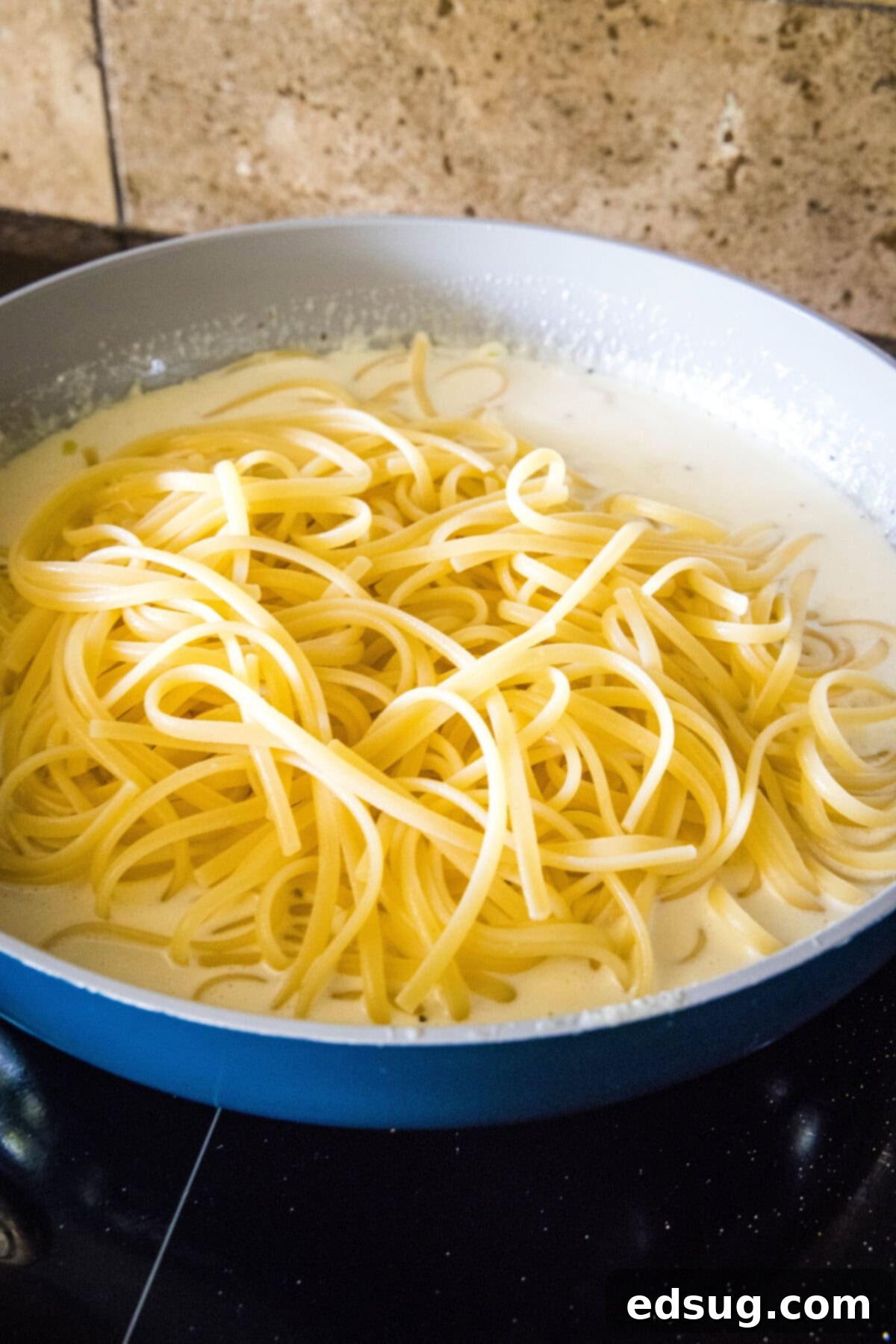
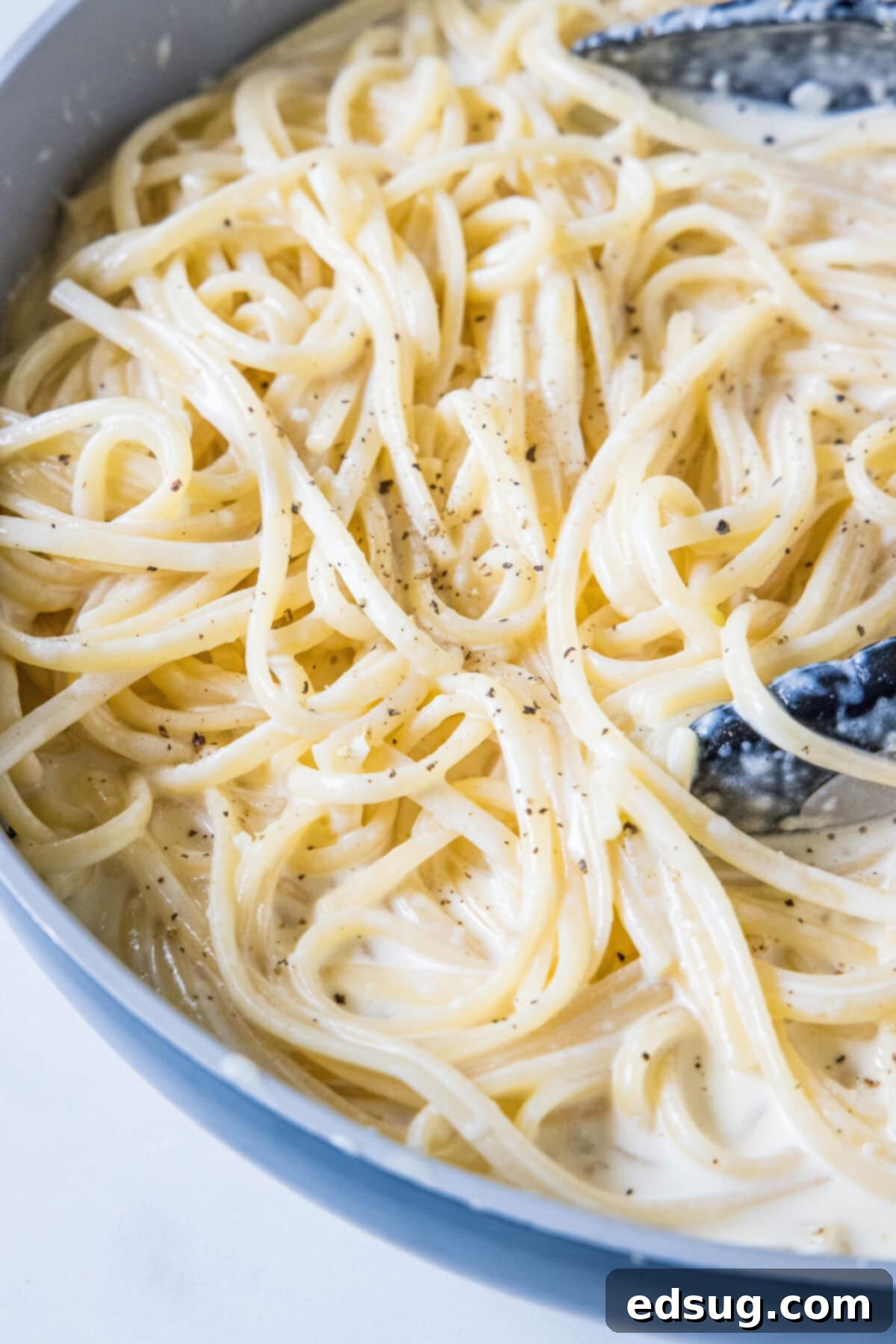
- Boil the pasta to perfection. Cook your fettuccine noodles in generously salted water until they are al dente – that is, tender but still firm to the bite – following the package directions. This ensures the pasta retains a pleasant texture and doesn’t become mushy when combined with the sauce.
- Combine pasta and sauce. Once cooked, drain the fettuccine well (reserving about a cup of the starchy pasta water!). Immediately add the hot, cooked pasta directly to the skillet containing your freshly prepared Alfredo sauce. The warmth of the pasta will help the sauce adhere beautifully.
- Toss to coat thoroughly. Using kitchen tongs or a large spatula, gently toss the fettuccine with the Alfredo sauce until every strand is evenly coated in its creamy embrace. For an extra velvety sauce that truly emulsifies and clings to the pasta, I highly recommend adding a couple of spoonfuls of the reserved pasta water. The starches in the water help to bind the sauce to the noodles. Serve your exquisite fettuccine Alfredo immediately, garnished with a sprinkle of extra Parmesan cheese, and savor every delightful bite!
Even if fettuccine isn’t on hand, this versatile Alfredo sauce pairs wonderfully with almost any type of pasta. Consider other long-cut options like linguine or spaghetti for a similar feel. Alternatively, short-cut pastas such as penne, rigatoni, or fusilli work beautifully, allowing the creamy sauce to nestle into their nooks and crannies. It’s also an excellent choice for rich filled pastas like tortellini or ravioli, adding a luxurious coating to every dumpling.
The Secret to Thick Alfredo Sauce
A perfectly thick and creamy Alfredo sauce is the hallmark of a great dish. If your homemade Alfredo appears a bit too thin or watery, there are a few common culprits and straightforward solutions. Often, it could simply be that you didn’t add quite enough Parmesan cheese, which is crucial for both flavor and body. Alternatively, sometimes a newly made Alfredo sauce just needs a few minutes to stand off the heat, allowing it to naturally thicken as it cools slightly.
If standing doesn’t do the trick and you’re still facing a watery sauce, don’t despair! Here are some quick troubleshooting tips to bring your Alfredo back to its ideal, luscious consistency:
- If you haven’t added the Parmesan yet, you have the easiest fix! Simply return the heavy cream mixture to a gentle simmer (making sure it doesn’t boil) and allow it to cook for a few extra minutes. This will help more of the liquid to evaporate, naturally reducing and thickening the cream. It is essential to perform this step *before* incorporating the Parmesan, as adding cheese to boiling or overly hot liquid can cause it to clump or become stringy.
- If you’ve already added the Parmesan, your best course of action to thicken the Alfredo sauce is to create a cornstarch slurry. In a small bowl, whisk together 1 tablespoon of cornstarch with 1 tablespoon of cold water until smooth. Gradually stir this slurry into your simmering Alfredo sauce, a little at a time, whisking continuously. The sauce should begin to thicken almost immediately. If you don’t have cornstarch, you can achieve a similar effect by using a mixture of equal parts all-purpose flour and water. Remember to cook the sauce for at least 1-2 minutes after adding flour to eliminate any raw flour taste.
More Recipe Tips
Achieving a truly sublime homemade Alfredo sauce is all about technique and using the right ingredients. Beyond the core steps, here are a few more invaluable tips to ensure your Alfredo turns out perfectly smooth, rich, and flavorful every single time:
- Avoid boiling the sauce. This is perhaps the most critical rule when making dairy-based sauces. Alfredo sauce is rich in dairy components, including butter, heavy cream, and Parmesan. Dairy products are susceptible to splitting or curdling when exposed to excessively high temperatures or aggressive boiling. To prevent this unpleasant texture, ensure that your sauce remains at a gentle simmer – a soft bubble, not a rolling boil – throughout the cooking process, especially after adding the cream.
- Always use freshly grated Parmesan. I cannot stress this enough for the ultimate Alfredo experience. For the absolute best flavor profile and a silky-smooth texture in your homemade Alfredo, it is paramount to grate your Parmesan cheese fresh from a block. The pre-shredded “shaker” style Parmesan, often found in green containers, contains anti-caking agents like cellulose. These additives, while preventing clumping in the container, interfere with the cheese’s ability to melt seamlessly into the sauce, often resulting in a grainy or clumpy texture that detracts from the luxuriousness of Alfredo.
- Taste and adjust seasoning. Don’t be shy about tasting your sauce as it comes together. Adjust salt and pepper as needed. Remember, Parmesan cheese is salty, so add salt incrementally.
- Serve immediately. Alfredo sauce is best enjoyed fresh off the stove. As it cools, it will naturally thicken significantly. While it can be reheated, the initial fresh consistency is unparalleled.
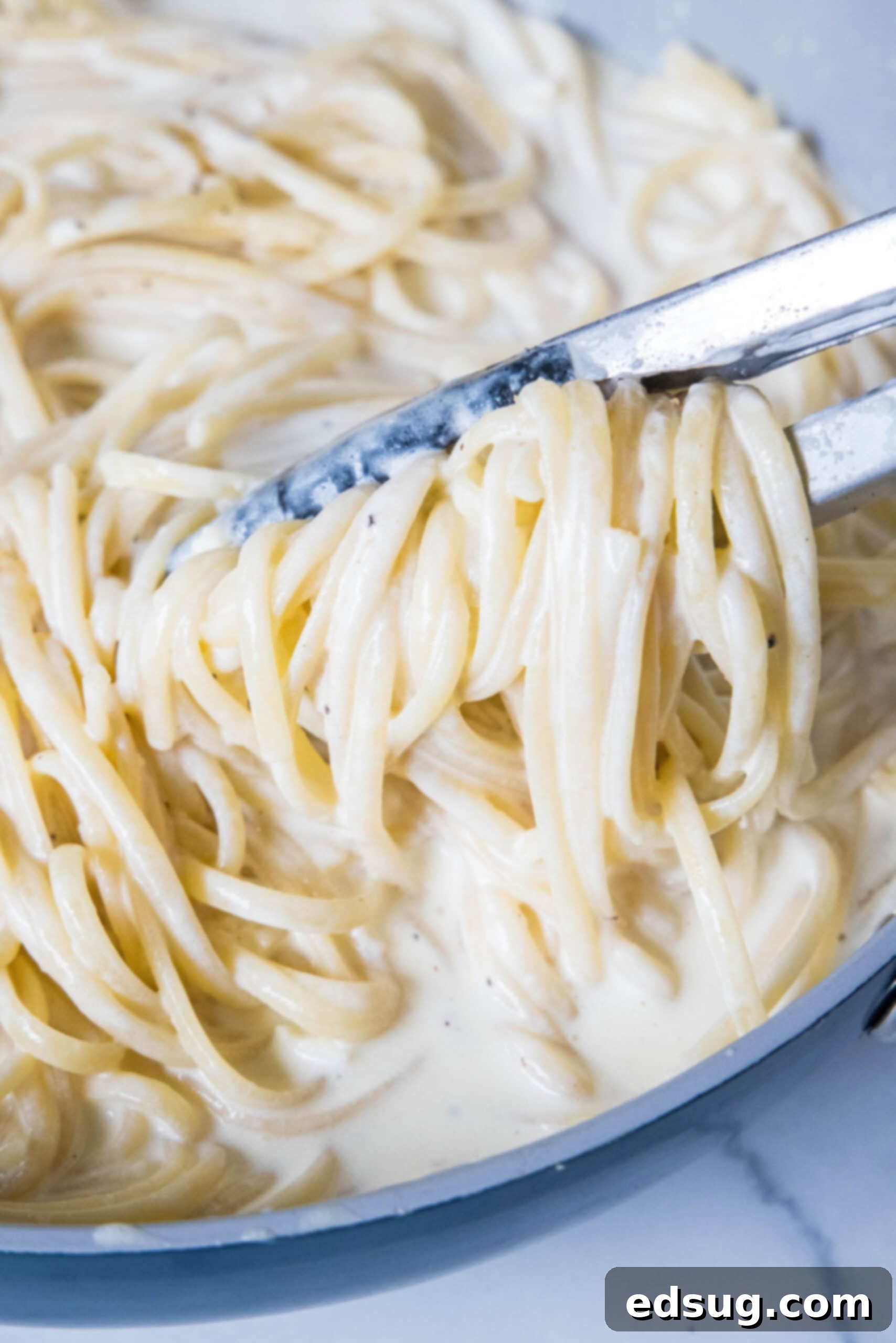
What Else Can I Add to Alfredo?
Alfredo is a beautifully versatile pasta sauce with a mild, rich base that readily adopts and enhances the flavors of whatever you choose to pair it with or incorporate into it. It acts as a perfect canvas for culinary creativity. Here are some fantastic and easy add-in ideas to infuse your homemade Alfredo with even more depth and excitement:
- Pesto. For a burst of vibrant flavor and a lovely herbaceous note, stir in 1-2 spoonfuls of fresh spinach pesto or traditional basil pesto. It adds a delightful color and an extra dose of greens to your meal.
- Fresh Herbs. Elevate the freshness of your Alfredo with a medley of finely chopped fresh herbs. Popular choices include fresh basil leaves, fragrant oregano, bright parsley, earthy thyme, or aromatic rosemary. Add them in the last minute of cooking or as a garnish for maximum impact.
- Seasonings. Beyond salt and pepper, consider a variety of spice blends. A touch of classic Italian seasoning can deepen its Mediterranean character, while Herbes de Provence (a French herb blend) adds a sophisticated aroma. For a bold and zesty twist, try a hint of Cajun seasoning, as I often do in my popular Cajun chicken Alfredo recipe.
- More Cheese. While Parmesan is key, don’t hesitate to explore other cheeses for a nuanced flavor profile. Melt in some creamy Ricotta for added richness, Gruyere for nutty depth, or a dollop of cream cheese for extra tang and thickness. A fun “flavor hack” is to stir in flavored cream cheese, like savory scallion or vibrant sun-dried tomato, for an instant gourmet upgrade.
- Veggies. Boost the nutritional value and texture of your Alfredo sauce by incorporating your favorite vegetables. Sautéed diced bell peppers, tender mushrooms, sweet carrots, crisp asparagus, vibrant green peas, wilted spinach or kale, or steamed broccoli florets (like in this delightful chicken broccoli Alfredo) are all excellent choices.
- Protein. Transform your simple homemade Alfredo into a complete and hearty meal by adding your choice of protein. Cooked and sliced chicken breast, savory sausage, or tender, juicy shrimp Alfredo are all fantastic additions that complement the creamy sauce beautifully.
Frequently Asked Questions
Parmesan cheese truly is the defining flavor and texture component in traditional Alfredo sauce, offering its distinct salty, nutty, and sharp notes. That being said, you absolutely can experiment with variations by using other types of melting cheeses. Options like creamy mozzarella, mild gouda, sharp cheddar, or even pungent Asiago cheese can create a delicious, albeit different, cream sauce. Feel free to play around with various combinations to discover a flavor profile that perfectly suits your palate!
Cheese clumping, or a grainy texture in your Alfredo sauce, is a common issue that can usually be attributed to two main factors: the type of cheese used and the temperature of your sauce. To prevent this, always choose freshly grated Parmesan from a block, as pre-shredded varieties contain anti-caking agents (like cellulose) that prevent smooth melting and can result in a gritty sauce. Secondly, it’s crucial to keep the sauce below a boil; high heat can cause the cheese proteins to seize and separate, leading to clumps. Remove the pan from direct heat or reduce it to very low before adding the Parmesan, and whisk gently until fully incorporated.
While Alfredo sauce is best enjoyed freshly made for optimal creaminess and texture, you can certainly prepare it a few hours in advance. Store it in an airtight container in the refrigerator. When reheating, it’s normal for the sauce to thicken considerably. Gently warm it over low heat, whisking frequently and gradually adding a splash of milk, cream, or pasta water until it returns to your desired consistency. Avoid high heat to prevent separation.
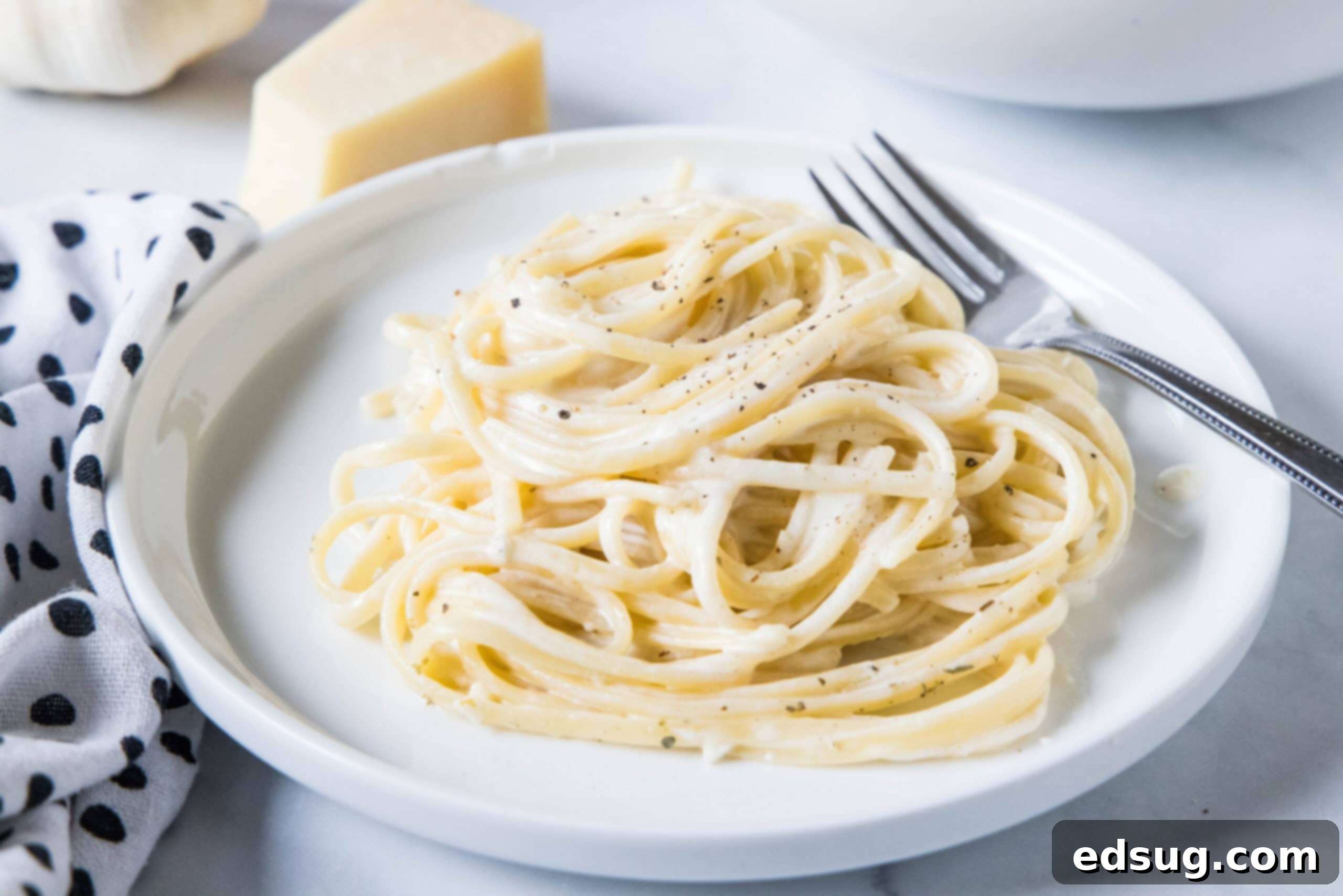
Serving Suggestions
A perfectly crafted homemade Alfredo pasta deserves to be accompanied by complementary sides that enhance its richness without overwhelming it. Here are some of my favorite pairings, ranging from light and fresh to hearty and comforting, ensuring a well-rounded and delightful meal:
- Crisp Salads: A refreshing salad provides a welcome contrast to the creamy pasta. My top choice is a vibrant chicken Caesar salad, with its crisp romaine, tangy dressing, and savory chicken offering a delightful balance. A simple mixed green salad with a light vinaigrette also works beautifully.
- Roasted Vegetables: Roasted veggies add earthy flavors and a touch of elegance. Think tender roasted asparagus, lightly charred roasted green beans with sesame and garlic, or even roasted broccoli or Brussels sprouts. The slight char from roasting adds depth that complements the creamy sauce.
- Artisan Breads: No pasta dish is complete without something to soak up every last drop of that incredible sauce! An easy starter of fluffy rosemary focaccia served with fragrant bread dipping oil is always a hit. Alternatively, classic homemade garlic bread or even fresh tomato bruschetta offers a perfect accompaniment.
- Protein Options: If you’re not already adding protein directly to your Alfredo (like chicken or shrimp), serving a simple grilled chicken breast or pan-seared scallops on the side can complete the meal without heavy preparation.
Storing and Reheating Leftovers
While homemade Alfredo is undeniably at its best enjoyed fresh, you can certainly save any delicious leftovers for another meal. Proper storage and gentle reheating are key to maintaining its creamy texture. Here’s how to handle your Alfredo sauce or pasta with sauce:
- Refrigerate. To keep your Alfredo sauce or leftover pasta with sauce fresh, transfer it to an airtight container or a jar with a tight-fitting lid. Stored correctly, it will happily last for up to 5 days in the refrigerator. Ensure it cools down sufficiently before covering and placing in the fridge to prevent condensation.
- Reheat. When you’re ready to enjoy your leftovers, reheat the Alfredo sauce gently. You can warm it with or without the pasta already mixed in. The sauce will likely have thickened considerably in the fridge. To loosen it back up to its desired creamy consistency, I recommend slowly sprinkling in a little milk, heavy cream, or even a splash of water while warming it over low heat on the stovetop, whisking continuously. Avoid high heat or boiling, as this can cause the dairy to separate and become grainy.
- Freeze. Freezing Alfredo sauce is possible, but it comes with a caveat. Due to its high dairy content, you might notice that the sauce’s texture can change once it’s thawed and reheated, sometimes becoming slightly grainy or separated. If you do choose to freeze it, store it in a freezer-safe, airtight container for up to 3 months. For best results, thaw the sauce overnight in the refrigerator before gently reheating with added liquid, as described above, to restore its creaminess.
More Homemade Pasta Sauces
If you’ve fallen in love with the ease and flavor of this homemade Alfredo, you’re in for a treat! Mastering a few staple pasta sauces can revolutionize your weeknight dinners. Explore these other fantastic homemade pasta sauce recipes that are just as satisfying and simple to make:
- Instant Pot Bolognese: A rich, slow-simmered meat sauce made effortlessly in a fraction of the time.
- Arugula Pesto: A vibrant, peppery pesto with walnuts for a unique twist on a classic green sauce.
- Pappardelle Pasta in Mushroom Sauce: Earthy mushrooms combined in a luscious sauce, perfect for wide, flat pasta.
- One Pot Spaghetti with Meat Sauce: The ultimate fuss-free dinner, where everything cooks in a single pot!
- Linguini with Beef Ragu Sauce: A hearty and deeply flavorful beef ragu, slow-cooked to perfection and ideal for coating linguini.
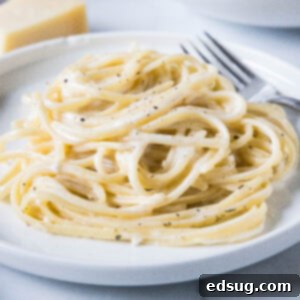
Homemade Alfredo
Pin Recipe
Rate Recipe
Print Recipe
Ingredients
- 4 Tablespoons unsalted butter
- 2 cloves garlic, minced
- 1 ½ cups heavy cream
- 1 ½ cups grated Parmesan cheese
- Salt and pepper to taste
Instructions
-
In a saucepan or large skillet melt the butter over medium heat. Add the garlic and saute for 1-2 minutes until you can start to smell it.4 Tablespoons unsalted butter, 2 cloves garlic
-
Whisk in the heavy cream and simmer for 5 minutes, being careful not to boil.1 ½ cups heavy cream
-
Stir in the Parmesan cheese, whisking until smooth. Season with salt and pepper to taste.1 ½ cups grated Parmesan cheese, Salt and pepper to taste
Notes
- This recipe yields enough sauce for 1 pound of pasta.
- Nutritional information does not include your choice of pasta.
Nutrition
Nutrition information is automatically calculated, so should only be used as an approximation.
Additional Info
Like this recipe? Leave a comment below!
I created a fun group on Facebook, and I would love for you to join us! It’s a vibrant community where you can
share YOUR favorite recipes, ask questions, and stay updated on what’s new at Dinners, Dishes and Desserts (so that you never miss a new recipe)!
Be sure to follow me on Instagram and
tag #dinnersdishes so I can see all the wonderful DINNERS, DISHES, AND DESSERTS
recipes YOU create and enjoy!
Connect with me on social media to ensure you
never miss a delicious post, tip, or new recipe!
Facebook | Twitter | Pinterest | Instagram
.
